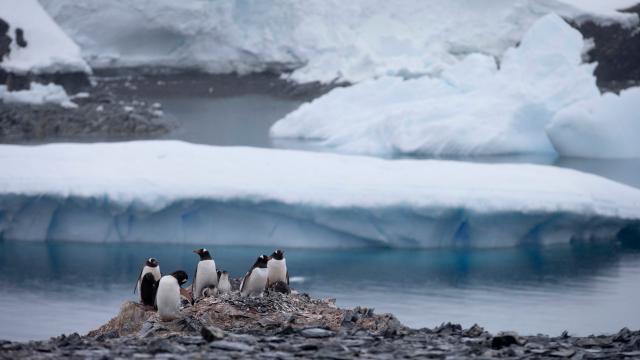The Antarctic is teeming with microscopic life: Mites, water bears, and roundworms squirm around, invisible to the naked eye. In fact, the Antarctic is full of biodiversity hotspots—and they’re thanks to penguin and elephant seal poop.
A new study published Thursday in the journal Current Biology tracked how nutrients from sea make their way onto land by big animals eating fish and then coming ashore to shit. Their poop eventually fuels the cycle that gives life to the frozen continent.
Water availability and temperature are factors scientists already know influence life in this desolate ecosystem, but this study is the first to examine the impact good ol’ poo is having on the environment.
Many animals are known to benefit their ecosystems by dropping the occasional deuce — from whales to hippos — but these creatures poop in environments that have, well, a lot more life than the South Pole does. Antarctica’s cold, dry climate isn’t all that amicable to biodiversity.
The authors conducted this study by sending Stef Bokhorst, an ecologist at the VU University Amsterdam, to the Antarctica Peninsula where he sampled three locations near seal and penguin colonies to see how much nitrogen levels were elevated around them. Then, he measured the abundance of living organisms, including tiny invertebrates invisible to the human eye, as well as lichen and moss.
The team found that the lichen and moss were unaffected by poop for the most part, but micro-arthropods were. These animals were two to eight more abundant in sampled regions tainted by penguin and elephant seal poop than in regions that weren’t. Water bears were barely affected, but springtail and mites benefited. Even predatory nematodes were found, showing a mini food web in action.
One of the coolest findings, perhaps, is that this impact stretched far beyond where colonies were concentrated. You see, the nutrients don’t just stay where the droppings land. The nitrogen can travel some miles away from the coastlines where the penguins and seals hang out because it evaporates as ammonia gas, which the wind blows inland, explained Bokhorst.
Using the data they collected and the locations of other penguin colonies Bokhorst couldn’t get close to, his team mapped out likely biodiversity hotspots across the Antarctica Peninsula. If their analysis is right, well, the peninsula is popping with microscopic critters.
This study shows the important role marine vertebrates like penguins and elephant seals play in their ecosystems. It also shows what’s at risk if we lose them, said Bokhorst. And some populations are facing serious threats.
An entire penguin colony hasn’t recovered since 2016 when a storm wiped out thousands of eggs and chicks. Events like this could become more common as our climate warms, threatening key habitats for large animals in Antarctica.
The peninsula, in particular, saw rapid late 1990s, and if it continues, that’s bad news for the animals that rely on the ice to breed and, well, live.
And if we lose these big, charismatic species, biodiversity hotspots could start to unravel. Still, Bokhorst is hopeful. He imagines climate change will wind up moving these hotspots around, not erasing them entirely. Guess we’ll have to wait and see.
